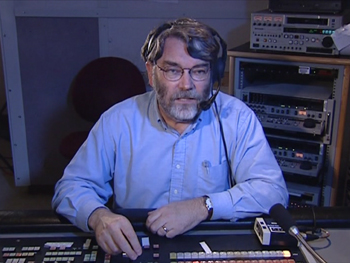 When I worked at the ResearchChannel and when I produced educational videos at the University of Washington’s UWTV I was often told by academics that the quality of the video did not matter. The only thing that was important was the content. While I whole heartedly agree that content is the key to effective educational videos and online courses I have always said that poor production quality interferes with the student’s ability to learn the content. It seems that many educators have a blind spot with video. They would not publish a text book with misspellings, poor graphics, smudged text or cheap binding yet they produce videos that the most dedicated student cannot sit through. To address some of these issues at the ResearchChannel I wrote and produced the TV Waste Land Zone.
When I worked at the ResearchChannel and when I produced educational videos at the University of Washington’s UWTV I was often told by academics that the quality of the video did not matter. The only thing that was important was the content. While I whole heartedly agree that content is the key to effective educational videos and online courses I have always said that poor production quality interferes with the student’s ability to learn the content. It seems that many educators have a blind spot with video. They would not publish a text book with misspellings, poor graphics, smudged text or cheap binding yet they produce videos that the most dedicated student cannot sit through. To address some of these issues at the ResearchChannel I wrote and produced the TV Waste Land Zone.
Video Quality Control
The producers of MOOC (Massive Open Online Courses) videos seem to be falling into this same frame of thinking. While I’ve seen many outstanding videos offered on the MOOCs there are still a distressingly high percentage of them that do not even meet the minimum standards of Public Access TV. If your MOOC has one or more of the following production quality issues do not be surprised if you have a low viewer completion rate.
- Bad Sound Quality: Sound is the Achilles’ heel of most educational videos. Most people will put up with poor video but if you cannot hear or understand what is being said there is no use in watching any further. These problems are usually caused by poor microphone placement, low recording levels, background noise and talent who do not speak well on camera.
- Poor Lighting: Even bad cameras look good when there is plenty of light yet many videos look as if they were videotaped in a closet. If a student is going to stare at your video for 15 to 60 minutes at least make the images visible.
- Poor Graphics: Just like unintelligible sound, unreadable graphics are useless. If the viewer cannot read or follow the graphic why include it? This is more than a PowerPoint slide with small text, this includes flow charts that are so dense and detailed they cannot be followed or photographs of such poor quality it is hard to tell what they are.
- All Text Presentations: If the only thing the presenter is doing is reading the text off of one PowerPoint slide after another why not just send the student the PowerPoint slides?
- Talking Heads: Or even worse, talking shadows on a distant stage. Videotaping lectures is probably the quickest and easiest way to record educational content but it does not have to be the most boring way to present educational content. I’ve written several blogs on videotaping lectures, including how I think the TED Lectures get it right.
- Long Videos: One of the best features of online videos and MOOC classes is that the professor is not required to lecture for 50 minutes as they are often required to in a scheduled class. They can make the video segment as long, or as short as it needs to be. Yet many online classes are 50 or 60 minutes because that is the length of a traditional classroom lecture. If students fall asleep in a classroom during a long lecture they will fall asleep faster during a long video lecture.
- Not Using the Medium: Why, in this new world of television production where an inexpensive HD video camera can fit in the palm of your hand, do so many of the online video classes take place behind a lectern? Are cameras not allowed in the lab or out in the field? Is it impossible to interview an expert or illustrate a concept with animation? Television is personal and mobile. Take advantage of its strengths.
As I said in my last blog on MOOCs Online Courses and the New World of Free Educational Video, there are a lot of experienced experts on how to improve the quality of your online educational courses. There are ways to improve production quality and the quality of your programs that will improve the effectiveness of your overall online course.
Are you involved in producing video for MOOCs? What are your biggest production quality challenges? What obstacles do you face in producing your videos? Let me know in the discussion section below. If you are involved in producing educational video and would like some feedback on your production quality then contact us for a free video consultation.




